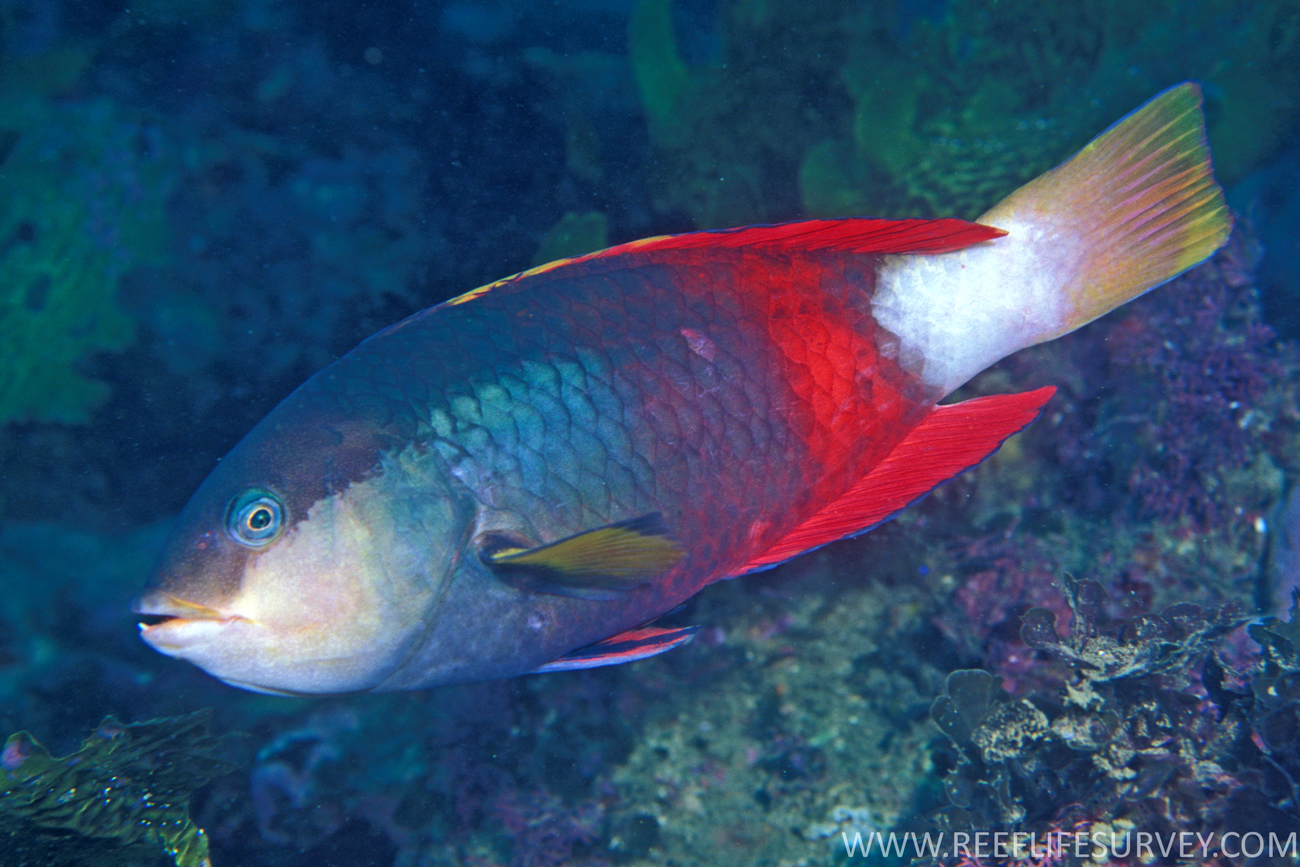- Classification
- ACTINOPTERYGII
- PERCIFORMES
- LABRIDAE
- Notolabrus
- gymnogenis
Crimsonband Wrasse, Notolabrus gymnogenis (Günther 1862)

A male Crimsonband Wrasse, Notolabrus gymnogenis, at South Solitary Island, New South Wales. Source: Ian V. Shaw / Reef Life Survey. License: CC BY Attribution
Juveniles are greenish brown with rows of white spots along the sides. Females are reddish to brownish-orange with rows of white spots along the sides. Males are strikingly coloured with red dorsal and anal fins, a red band around the rear of the body, a white caudal peduncle and a yellow caudal fin.
Video of a male Crimsonband Wrasse at Shelly Beach (Manly), New South Wales.
Crimsonband Wrasse, Notolabrus gymnogenis (Günther 1862)
More Info
|
Distribution |
Endemic to eastern Australia, from Hervey Bay, Queensland, to Lakes Entrance, Victoria, and the Kent Group, Bass Strait, Tasmania; also the Lord Howe Province in the Tasman Sea. Commonly inhabits exposed and moderately exposed kelp-covered reefs in New South Wales. |
|
Feeding |
Carnivore - feeds mostly on benthic invertebrates. Juveniles mostly consume amphipods, whereas larger fish prey on decapod crustaceans, and gastropod and bivalve molluscs. |
|
Biology |
A protogynous hermaphrodite - individuals change sex from female to male at about 5 years and a length of about 260-280 mm TL. Spawning occurs from April to October, and the eggs and larvae are pelagic. |
|
Fisheries |
Fished on a small scale commercially and recreationally. |
|
Conservation |
|
|
Remarks |
Adult males are highly territorial, and may defend their reef from other males for more than two years. They live in a harem, sharing their territory with up to 10 juvenile and female individuals. |
|
Etymology |
The specific name gymnogenis is from the Greek gymnos (= bare) and genys (= cheek), in reference to the fact that the cheeks are almost naked, having only a single row of scales. |
|
Species Citation |
Labrichthys gymnogenis Günther, 1862, Cat. Fishes Brit. Mus.4: 117, 507. Type locality: Sydney, New South Wales. |
|
Author |
Bray, D.J. 2024 |
|
Resources |
Crimsonband Wrasse, Notolabrus gymnogenis (Günther 1862)
References
Coleman, N. 1980. Australian Sea Fishes South of 30ºS. Lane Cove, NSW : Doubleday Australia Pty Ltd 309 pp.
Fetterplace, L.C., Turnbull, J.W., Knott, N. A. & Hardy, N.A. 2018. The devil in the deep: Expanding the known habitat of a rare and protected fish. European Journal of Ecology 4(1): 22-29. https://doi.org/10.2478/eje-2018-0003
Francis, M. 1993. Checklist of the coastal fishes of Lord Howe, Norfolk, and Kermadec Islands, southwest Pacific Ocean. Pacific Science 47(2): 136-170 figs 1-2
Günther, A. 1862. Catalogue of the Fishes in the British Museum. Catalogue of the Acanthopterygii Pharyngognathi and Anacanthini in the collection of the British Museum. London : British Museum Vol. 4 534 pp. See ref at BHL
Johnson, J.W. 1999. Annotated checklist of the fishes of Moreton Bay, Queensland, Australia. Memoirs of the Queensland Museum 43(2): 709-762
Kuiter, R.H. 1993. Coastal Fishes of South-eastern Australia. Bathurst : Crawford House Press 437 pp.
Kuiter, R.H. 1997. Guide to sea fishes of Australia. A comprehensive reference for divers and fishermen. Frenchs Forest, NSW, Australia : New Holland Publishers I-xvii, 434 pp.
Last, P.L., White, W.T., Gledhill, D.C., Hobday, A.J., et al. 2011. Long-term shifts in abundance and distribution of a temperate fish fauna: a response to climate change and fishing practices. Global Ecology and Biogeography 20: 58–72
Macleay, W.J. 1878. Descriptions of some new fishes from Port Jackson and King George's Sound. Proceedings of the Linnean Society of New South Wales 1 3(1): 33-37 pls 2-5 [described as Labrichthys nigromarginatus, type locality Port Jackson, New South Wales]
Marshall, T.C. 1964. Fishes of the Great Barrier Reef and Coastal Waters of Queensland. Sydney : Angus & Robertson 566 pp. 136 pls.
McPherson, G.R. 1977. Sex change in the wrasse Pseudolabrus gymnogenis (Labridae). Australian Zoologist 19: 185-200.
Morton, J.K., Gladstone, W. Hughes, J.M. & Stewart, J. 2008. Comparison of the life histories of three co-occurring wrasses (Teleostei: Labridae) in coastal waters of south-eastern Australia. Marine and Freshwater Research 59(7): 560-574.
Morton, J.K., Platell, M.E. & Gladstone, W. 2008. Differences in feeding ecology among three co-occurring species of wrasse (Teleostei: Labridae) on rocky reefs of temperate Australia. Marine Biology 154: 577–592.
Roughley, T.C. 1957. Fish and Fisheries of Australia. Sydney : Angus & Robertson 341 pp.
Russell, B.C. 1988. Revision of the labrid fish genus Pseudolabrus and allied genera. Records of the Australian Museum, Supplement 9: 1-72. https://doi.org/10.3853/j.0812-7387.9.1988.95
Russell, B. 2010. Notolabrus gymnogenis. The IUCN Red List of Threatened Species 2010: e.T187633A8586162. https://dx.doi.org/10.2305/IUCN.UK.2010-4.RLTS.T187633A8586162.en. Accessed on 12 February 2024.
Thomson, J.M. 1978. A Field Guide to the Common Sea & Estuary Fishes of Non-tropical Australia. Sydney : Collins 144 pp.
Waite, E.R. 1903. Additions to the fish-fauna of Lord Howe Island. No. 3. Records of the Australian Museum 5(1): 20-45 figs 1-2 pls 3-5














